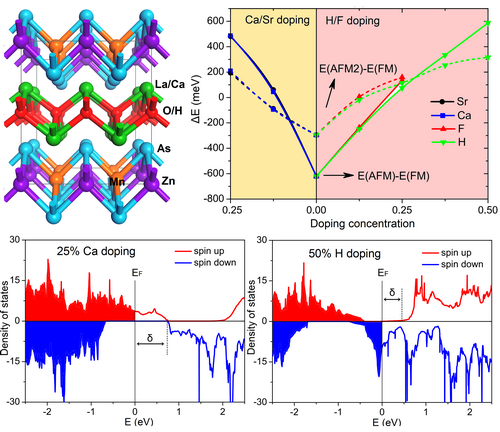The research group of Prof. YANG Jinlong from Hefei National Laboratory for Physical Sciences at Microscale has made new progress in theoretical design of room temperature half-metallic ferromagnets, which makes it possible to fabricate spintronic devices working at room temperature. The paper has been published in J. Am. Chem. Soc online (DOI: 10.1021/ja412317s).

Spintronics, which exploits the spin of electrons for information processing, have great potential advantages compared with the conventional charge-based electronic devices, such as speeding up data processing, high circuit integration density, and low energy consumption. Due to the capability of providing completely spin-polarized carriers, half-metallic ferromagnets are viewed as ideal spintronic materials. To develop practicable spintronic devices, half-metallic ferromagnet should have a Curie temperature notably higher than room temperature, a wide half-metallic gap and large bulk magnetic anisotropy energy. Up to now, there is still no candidate to fulfill all these requirements.
Based on two experimentally synthesized rare earth element transition metal arsenide oxides, that is, LaMnAsO and LaZnAsO, the group of Prof. Jinlong Yang design a new layered La(Mn0.5 Zn0.5)AsO alloy. At its ground state, the pristine La(Mn0.5Zn0.5)AsO alloy is an antiferromagnetic semiconductor. Either hole doping via (Ca2+/Sr2+,La3+) substitutions or electron doping via (H-/F-,O2-) substitutions in the [LaO]+ layer induce half-metallicity in the alloy. The half-metallic gap is as large as 0.74 eV. Monte Carlo simulations based on the Ising model predict a Curie temperature of 475K for 25% Ca doping and 600K for 50% H doping, respectively. Moreover, the quasi two-dimensional structure endows the doped La(Mn,Zn)AsO alloy a sizable magnetic anisotropy energy with the magnitude of at least one order larger than those of Fe, Co and Ni bulks. This work provides a clear route for systhesis of room temperature half-metallic ferromagnets.
The above research was supported by Chinese Academy of Sciences, Ministry of Science and Technology, National Natural Science Foundation and Synergetic Innovation Center of Quantum Information and Quantum Physics.
(HFNL)